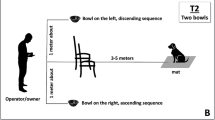Summary
Pure tonal ‘whistle’ vocalizations from five species of dolphins found in the western North Atlantic had consistent, species-specific characteristics. The degree of differences between species, as based on the results of multivariate discriminant analysis (Fig. 2), correlated with the taxonomic and zoogeographic relations of the five dolphin species. Congeneric species had more similar vocalizations than species of different genera. Differences between sympatric species were greater than differences between allopatric species. Of the six whistle parameters measured, maximum frequency had the lowest coefficient of variation for all five species, and duration and number of inflection points had the highest coefficients of variation for all five species.
Similar content being viewed by others
References
Au WWL, Floyd RW, Penner RH, Murchison AE (1974) Measurements of echolocation signals of the Atlantic bottlenosed dolphin, Tursiops truncatus Montagu, in open waters. J Acoust Soc Am 56:1280–1290
Au WWL, Floys RW, Haun JE (1978) Propagation of Atlantic bottlenose dolphin echolocation signals. J Acoust Soc Am 64:411–422
Barr AJ, Goodnight JH, Sail JP, Helwig JT (1976) SAS 76. SAS Institute, Raleigh, NC
Busnel RG, Fish JF (eds) (1980) Animal sonar systems. Plenum Publishing, New York
Caldwell MC, Caldwell DK (1965) Individualized whistle contours in bottlenosed dolphins (Tursiops truncatus). Nature 207:529–531
Caldwell MC, Caldwell DK (1968) Vocalizations of naive captive dolphins in small groups. Science 159:1121–1123
Caldwell MC, Caldwell DK (1977) Cetaceans. In: Sebeok TA (ed) How animals communicate. Indiana University Press, Bloomington, IN
CETAP (1979) Unpublished observation of the Cetacean and Turtle Assessment Program, University of Rhode Island. Characterization of the marine mammals and turtles in the Mid- and North-Atlantic areas of the US outer continental shelf. Bureau of Land Management, Washington, DC
Dixon WJ (ed) (1975) BMDP Biomedical computer programs. University of California Press, Berkeley, CA
Emlen ST (1972) An experimental analysis of the parameters of bird song eliciting species recognition. Behaviour 41:130–171
Evans WE (1973) Echolocation by marine delphinids and one species of fresh-water dolphin. J Acoust Soc Am 54:191–199
Hutchinson RE, Stevenson JG, Thorpe WE (1968) The basis for individual recognition by voice in the sandwich tern (Sterna sandvicensis). Behaviour 32:150–157
Katona S, Steiner WW, Winn HE (1977) Marine mammals. In: A summary and analysis of environmental information on the continental shelf from Bay of Fundy to Cape Hatteras. Bureau of Land Management, Washington, DC
Lang TG, Smith HAP (1965) Communication between dolphins in separate tanks by way of an electronic acoustic link. Science 150:1839–1843
Lilly JC, Miller AM (1961a) Sounds emitted by the bottlenosed dolphin. Science 134:1689–1693
Lilly JC, Miller AM (1961b) Vocal exchanges between dolphins. Science 134:1873–1876
Nishiwaki M (1972) General biology. In: Ridgway SH (ed) Mammals of the sea. Biology and medicine. Thomas, Springfield, IL
Perrin WF (1975a) Variation of spotted and spinner porpoise (Genus Stenella) in the eastern tropical Pacific and Hawaii. Bull Scripps Inst Oceanogr 31:1–206
Perrin WF (1975b) Distribution and differentiation of populations of dolphins of the genus Stenella in eastern tropical Pacific. J Fish Res Board Can 32:1059–1067
Schevill WE, Lawrence B (1949) Underwater listening to the white porpoise Delphinapterus leucas. Science 109:143–144
Steiner WW (1980) A comparative study of the pure tonal whistle vocalizations from five western North Atlantic dolphin species. PhD dissertation, University of Rhode Island, Kingston, RI
Taruski AG (1976) Whistle of the pilot whale Globicephala spp: Variation in whistling related to behavioral-environmental context, broadcast of underwater sounds, and geographic location. PhD dissertation, University of Rhode Island, Kingston, RI
Watkins WA (1980) Click sounds from animals at sea. In: Busnel RG, Fish JF (eds) Animal sonar systems. Plenum Press, New York
Wilson EO (1975) Sociobiology. Belknap Press, Cambridge, MA
Wunderle JM (1979) Components of song used for species recognition in the common yellowthroat. Anim Behav 27:982–996
Author information
Authors and Affiliations
Rights and permissions
About this article
Cite this article
Steiner, W.W. Species-specific differences in pure tonal whistle vocalizations of five western North Atlantic dolphin species. Behav Ecol Sociobiol 9, 241–246 (1981). https://doi.org/10.1007/BF00299878
Received:
Accepted:
Issue Date:
DOI: https://doi.org/10.1007/BF00299878




